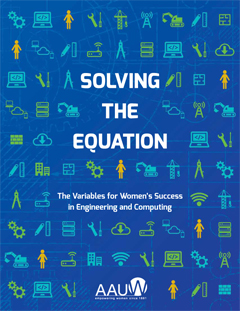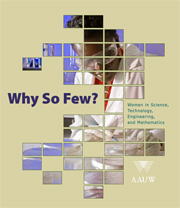AAUW conducts groundbreaking research that draws national attention to issues of gender equity in education and the workplace; influences policy-makers as well as educators, parents, and students; and, most importantly, serves as a catalyst for action. Recent reports address topics such as the pay gap between men and women, economic security of older women, sexual harassment on college campuses, and gender equity in science and engineering education.
Solving the Equation: The Variables for Women’s Success in Engineering and Computing (2015)
Solving the Equation: The Variables for Women’s Success in Engineering and Computing asks why there are still so few women in the critical fields of engineering and computing — and explains what we can do to make these fields open to and desirable for all
More than ever before, girls are studying and excelling in science and mathematics. Yet the dramatic increase in girls’ educational achievements in scientific and mathematical subjects has not been matched by similar increases in the representation of women working as engineers and computing professionals. Just 12 percent of engineers are women, and the number of women in computing has fallen from 35 percent in 1990 to just 26 percent today.
Why So Few? (2010)
In an era when women are increasingly prominent in medicine, law, and business, why are there so few women scientists and engineers? A 2010 research report by AAUW presents compelling evidence that can help to explain this puzzle. Why So Few? Women in Science, Technology, Engineering, and Mathematics (STEM) presents in-depth yet accessible profiles of eight key research findings that point to environmental and social barriers — including stereotypes, gender bias, and the climate of science and engineering departments in colleges and universities — that continue to block women’s progress in STEM. The report also includes up-to-date statistics on girls’ and women’s achievement and participation in these areas and offers new ideas for what each of us can do to more fully open scientific and engineering fields to girls and women.


